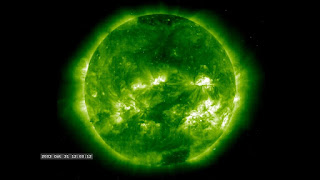Space, though vast and seemingly tranquil, is not without its dangers. Solar eruptions and space radiation are two invisible threats that can have severe consequences for space travelers and technology alike. In this blog post, we will delve into the science behind these phenomena, their potential impacts on astronauts and spacecraft, and the measures taken to mitigate these risks in the exploration of space.
Solar Eruptions: Unleashing the Power of the Sun
Solar eruptions, also known as solar flares and coronal mass ejections (CMEs), are powerful bursts of energy from the Sun's surface. These eruptions release immense amounts of charged particles, such as protons and electrons, into space. When these high-energy particles reach Earth, they can interact with the planet's magnetic field and atmosphere, causing various effects.
a. Space Weather Impact:
Solar eruptions can lead to space weather events, such as geomagnetic storms. These storms can disrupt satellite communications, GPS systems, and even power grids on Earth. For astronauts in space, the increased radiation exposure during such events poses health risks, making space missions more challenging.
b. Radiation Hazards:
During a solar eruption, the flux of high-energy particles in space significantly increases. Shielding spacecraft and astronauts from this radiation is crucial, as prolonged exposure can lead to radiation sickness, increased cancer risks, and damage to vital electronic systems onboard spacecraft.
Space Radiation: The Invisible Menace
Space radiation, also called cosmic radiation, is a constant stream of high-energy particles originating from various sources in the universe. These particles, including protons, neutrons, and heavier ions, travel at near the speed of light and can penetrate materials that are usually protective against terrestrial radiation.
a. Sources of Space Radiation:
The primary sources of space radiation include the Sun, distant supernovae, and even our own galaxy's center. Earth's magnetic field and atmosphere shield us from much of this radiation, but in space, astronauts are exposed to higher doses.
b. Health Effects on Astronauts:
Space radiation exposure can cause acute effects, such as radiation sickness, and long-term health issues, including an increased risk of cancer and damage to the central nervous system. Prolonged exposure during deep-space missions, like journeys to Mars, is a significant concern for the well-being of astronauts.
Mitigating the Risks: Protecting Astronauts and Technology
a. Spacecraft Shielding:
Space agencies like NASA and ESA are continuously researching advanced materials and designs for spacecraft shielding to minimize radiation exposure. Multilayered materials and water-filled compartments serve as effective barriers against high-energy particles.
b. Space Weather Monitoring:
To predict and prepare for solar eruptions, space weather monitoring systems are deployed both on Earth and in space. These systems provide crucial information to astronauts and mission control, enabling them to take preventive measures during spacewalks and other vulnerable situations.
c. Space Travel Limitations:
Long-term space missions beyond Earth's protective magnetosphere require careful planning and consideration of radiation exposure limits. Space agencies are working to develop countermeasures, such as pharmaceuticals that protect against radiation damage, to make interplanetary travel safer.
In conclusion, solar eruptions and space radiation are two invisible hazards that pose significant challenges to space exploration. As we venture deeper into the cosmos and aim to explore other planets, it becomes imperative to understand and mitigate these risks for the safety of astronauts and the success of missions. Through advancements in spacecraft shielding, space weather monitoring, and radiation protection measures, we can make progress in ensuring the well-being of our brave space pioneers. While these challenges are formidable, the rewards of space exploration in expanding our knowledge of the universe and potentially finding new habitats for humanity make the journey worth the effort and innovation.



.jpg)


No comments:
Post a Comment